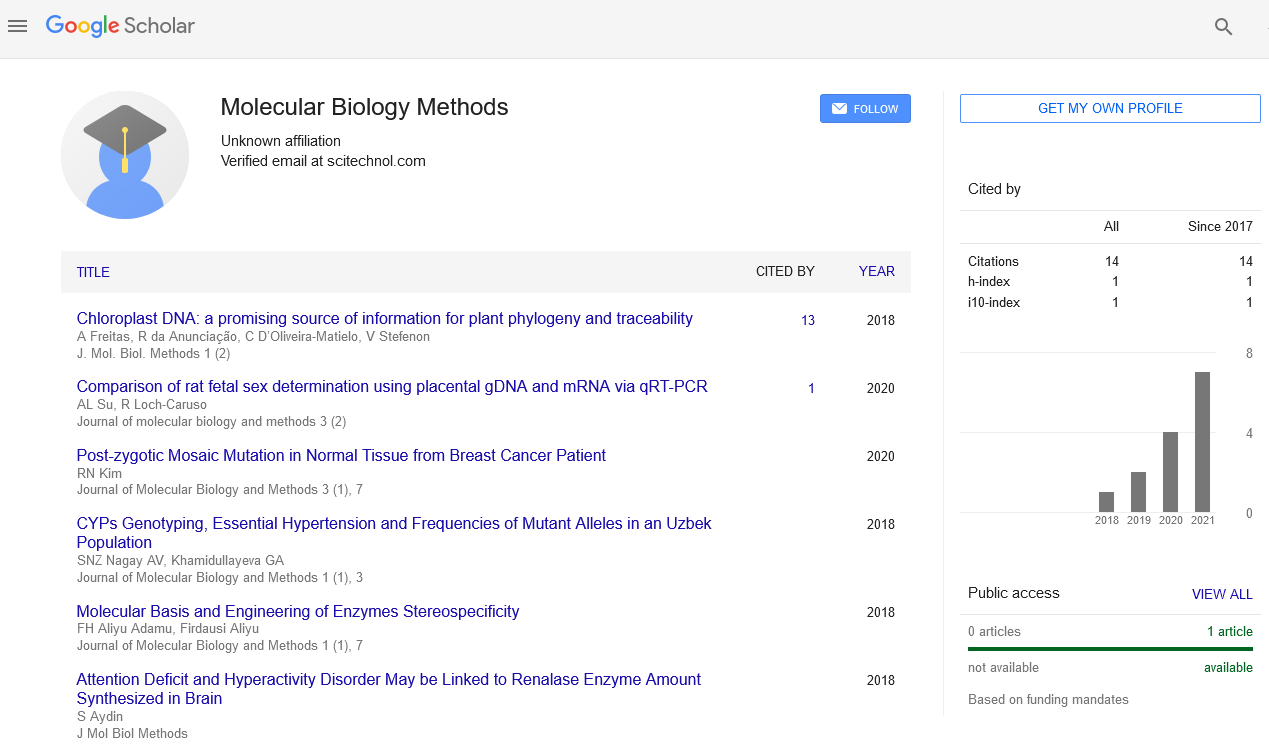Commentary, J Mol Biol Methods Vol: 7 Issue: 1
Exploring the Frontier: A Comprehensive Overview of Bioinformatics
Christopher Rin*
1Department of Molecular and Cell Biology, University of Leicester, Leicester, United Kingdom
*Corresponding Author: Christopher Rin,
Department of Molecular and Cell
Biology, University of Leicester, Leicester, United Kingdom
E-mail: rinchristopher@ac.uk
Received date: 26 February, 2024, Manuscript No. JMBM-24-136920;
Editor assigned date: 29 February, 2024, PreQC No. JMBM-24-136920 (PQ);
Reviewed date: 14 March, 2024, QC No. JMBM-24-136920;
Revised date: 21 March, 2024, Manuscript No. JMBM-24-136920 (R);
Published date: 28 March, 2024, DOI: 10.4172/JMBM.1000150
Citation: Rin C (2024) Exploring the Frontier: A Comprehensive Overview of Bioinformatics. J Mol Biol Methods 7:1.
Description
Bioinformatics stands at the intersection of biology, computer science, and information technology. It harnesses computational techniques to analyze, interpret, and manipulate biological data, thereby advancing our understanding of living organisms at molecular, cellular, and organismal levels. By integrating diverse disciplines, bioinformatics has become an indispensable tool in modern biological research, facilitating breakthroughs in fields ranging from genomics and proteomics to drug discovery and personalized medicine.
The roots of bioinformatics can be traced back to the mid-20th century with the emergence of molecular biology and the elucidation of the genetic code. However, it wasn't until the advent of highthroughput technologies in the late 20th and early 21st centuries that bioinformatics experienced exponential growth. The Human Genome Project, completed in 2003, marked a milestone by sequencing the entire human genome, laying the foundation for a data-driven approach to biology.
Bioinformatics encompasses a wide array of techniques and tools. Sequence analysis, perhaps the most prominent aspect, involves the alignment, comparison, and annotation of nucleotide or amino acid sequences. This includes tasks such as genome assembly, gene prediction, and sequence homology searching using algorithms like Basic Local Alignment Search Tool (BLAST).
Structural bioinformatics focuses on the three-dimensional structure of biomolecules, utilizing methods such as molecular modeling, protein folding prediction, and docking simulations to understand their functions and interactions. This branch has been instrumental in drug discovery and design, enabling the identification of potential drug targets and the development of novel therapeutics.
Systems biology takes a holistic approach, integrating computational and experimental methods to model and analyze complex biological systems. By constructing mathematical models of cellular processes and networks, researchers can simulate and predict their behavior under different conditions, leading to insights into disease mechanisms and drug responses.
Despite its transformative potential, bioinformatics faces several challenges. One major hurdle is the sheer volume and complexity of biological data generated by high-throughput technologies, which require sophisticated algorithms and computational resources for analysis. Additionally, integrating diverse datasets from multiple sources remains a daunting task due to differences in data formats, quality, and standards.
Furthermore, ethical and legal considerations, such as data privacy and security, pose significant challenges in the era of big data and genomic medicine. Ensuring responsible data sharing practices and protecting sensitive information are paramount to maintaining public trust and advancing research collaboration.
However, these challenges also present opportunities for innovation and collaboration. The rise of open-source software and cloud computing platforms has democratized access to bioinformatics tools and resources, enabling researchers worldwide to leverage state-ofthe- art technologies for their studies. Collaborative initiatives, such as the Global Alliance for Genomics and Health (GA4GH), promote data sharing and interoperability standards, fostering a culture of transparency and collaboration in the scientific community.
Looking ahead, bioinformatics is poised to play an increasingly prominent role in biology and medicine. Advances in artificial intelligence and machine learning are revolutionizing data analysis and interpretation, enabling the discovery of complex patterns and relationships in biological data that were previously inaccessible. Deep learning algorithms, in particular, have shown promise in predictive modeling, image analysis, and drug discovery, opening new avenues for research and innovation.
Moreover, the integration of multi-omics data, including genomics, transcriptomics, proteomics, and metabolomics, promises a more comprehensive understanding of biological systems and disease mechanisms. By combining information from different molecular layers, researchers can uncover hidden connections and identify novel biomarkers for disease diagnosis, prognosis, and treatment.
Bioinformatics represents a powerful interdisciplinary approach to biological research, driving innovation and discovery across diverse fields. By harnessing the synergies between biology, computer science, and data science, bioinformatics holds the potential to revolutionize our understanding of life and transform healthcare in the 21st century.
 Spanish
Spanish  Chinese
Chinese  Russian
Russian  German
German  French
French  Japanese
Japanese  Portuguese
Portuguese  Hindi
Hindi 